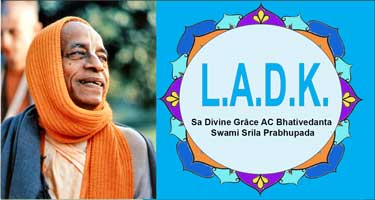
SRIMAD-BHAGAVATAM 7 CHAPTER 10 TEXT 42
eṣā brahmaṇya-devasya
kṛṣṇasya ca mahātmanaḥ
avatāra-kathā puṇyā
vadho yatrādi-daityayoḥ
TRANSLATION
In this narration about Kṛṣṇa, the Supreme Personality of Godhead, various expansions or incarnations of the Lord have been described, and the killing of the two demons Hiraṇyākṣa and Hiraṇyakaśipu has also been described.
PURPORT
Avatāras, or incarnations, are expansions of the Supreme Personality of Godhead—Kṛṣṇa, Govinda.
advaitam acyutam anādim ananta-rūpam
ādyaṁ purāṇa-puruṣaṁ nava-yauvanaṁ ca
vedeṣu durlabham adurlabham ātma-bhaktau
govindam ādi-puruṣaṁ tam ahaṁ bhajāmi
“I worship the Supreme Personality of Godhead, Govinda, who is the original person—nondual, infallible, and without beginning. Although He expands into unlimited forms, He is still the original, and although He is the oldest person, He always appears as a fresh youth. Such eternal, blissful and all-knowing forms of the Lord cannot be understood by the academic wisdom of the Vedas, but they are always manifest to pure, unalloyed devotees.” (Brahma-saṁhitā 5.33) The Brahma-saṁhitā describes the avatāras. Indeed, all the avatāras are described in the authentic scriptures. No one can become an avatāra, or incarnation, although this has become fashionable in the age of Kali. The avatāras are described in the authentic scriptures (śāstras), and therefore before one risks accepting a pretender as an avatāra, one should refer to the śāstras. The śāstras say everywhere that Kṛṣṇa is the original Personality of Godhead and that He has innumerable avatāras, or incarnations. Elsewhere in the Brahma-saṁhitā it is said, rāmādi-mūrtiṣu kalā-niyamena tiṣṭhan: [Bs. 5.39] Rāma, Nṛsiṁha, Varāha and many others are consecutive expansions of the Supreme Personality of Godhead. After Kṛṣṇa comes Balarāma, after Balarāma is Saṅkarṣaṇa, then Aniruddha, Pradyumna, Nārāyaṇa and then the puruṣa-avatāras—Mahā-Viṣṇu, Garbhodakaśāyī Viṣṇu and Kṣīrodakaśāyī Viṣṇu. All of them are avatāras.
One must hear about the avatāras. Narrations about such avatāras are called avatāra-kathā, the narrations of Kṛṣṇa’s expansions. Hearing and chanting these narrations is completely pious. Sṛṇvatāṁ sva-kathāḥ kṛṣṇaḥ puṇya-śravaṇa-kīrtanaḥ [SB 1.2.17]. One who hears and chants can become puṇya, purified of material contamination.
Whenever there are references to the avatāras, religious principles are established, and demons who are against Kṛṣṇa are killed. The Kṛṣṇa consciousness movement is spreading all over the world with two aims—to establish Kṛṣṇa as the Supreme Personality of Godhead and to kill all the pretenders who falsely present themselves as avatāras. The preachers of the Kṛṣṇa consciousness movement must carry this conviction very carefully within their hearts and kill the demons who in many tactful ways vilify the Supreme Personality of Godhead, Kṛṣṇa. If we take shelter of Nṛsiṁhadeva and Prahlāda Mahārāja, it will be easier to kill the demons who are against Kṛṣṇa and to thus reestablish Kṛṣṇa’s supremacy. Kṛṣṇas tu bhagavān svayam: Kṛṣṇa is the Supreme Lord, the original Lord. Prahlāda Mahārāja is our guru, and Kṛṣṇa is our worshipable God. As advised by Śrī Caitanya Mahāprabhu, guru-kṛṣṇa-prasāde pāya bhakti-latā-bīja. If we can be successful in getting the mercy of Prahlāda Mahārāja and also that of Nṛsiṁhadeva, then our Kṛṣṇa consciousness movement will be extremely successful.
The demon Hiraṇyakaśipu had so many ways to try to become God himself, but although Prahlāda Mahārāja was chastised and threatened in many ways, he rigidly refused to accept his powerful demoniac father as God. Following in the footsteps of Prahlāda Mahārāja, we should reject all the rascals who pretend to be God. We must accept Kṛṣṇa and His incarnations, and no one else.

